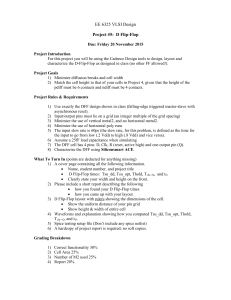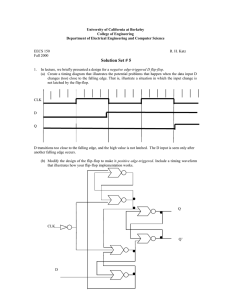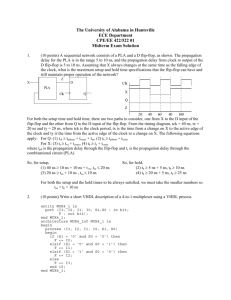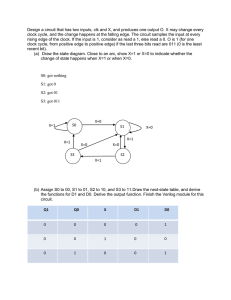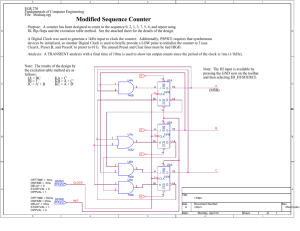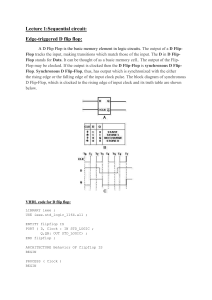Homework #2 - UAH Electrical and Computer Engineering Department
advertisement
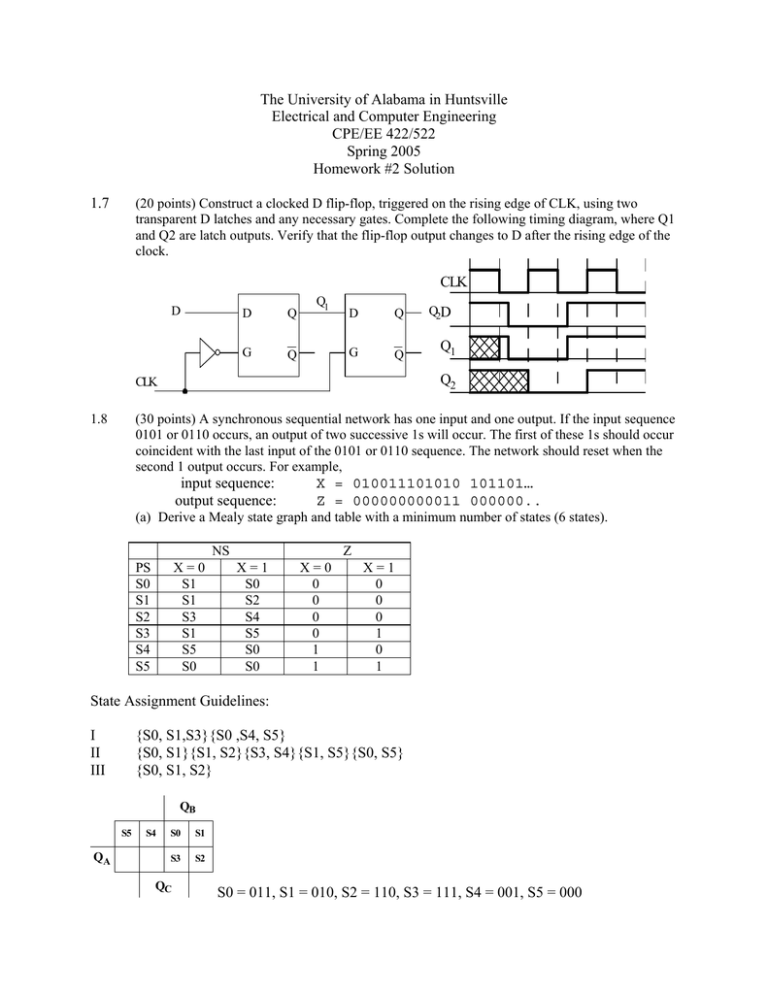
The University of Alabama in Huntsville
Electrical and Computer Engineering
CPE/EE 422/522
Spring 2005
Homework #2 Solution
1.7
(20 points) Construct a clocked D flip-flop, triggered on the rising edge of CLK, using two
transparent D latches and any necessary gates. Complete the following timing diagram, where Q1
and Q2 are latch outputs. Verify that the flip-flop output changes to D after the rising edge of the
clock.
CLK
D
D
Q
G
Q
Q1
D
Q
G
Q
Q1
Q2
CLK
1.8
Q2D
(30 points) A synchronous sequential network has one input and one output. If the input sequence
0101 or 0110 occurs, an output of two successive 1s will occur. The first of these 1s should occur
coincident with the last input of the 0101 or 0110 sequence. The network should reset when the
second 1 output occurs. For example,
input sequence:
output sequence:
X = 010011101010 101101…
Z = 000000000011 000000..
(a) Derive a Mealy state graph and table with a minimum number of states (6 states).
NS
PS
S0
S1
S2
S3
S4
S5
X=0
S1
S1
S3
S1
S5
S0
Z
X=1
S0
S2
S4
S5
S0
S0
X=0
0
0
0
0
1
1
X=1
0
0
0
1
0
1
State Assignment Guidelines:
I
II
III
{S0, S1,S3}{S0 ,S4, S5}
{S0, S1}{S1, S2}{S3, S4}{S1, S5}{S0, S5}
{S0, S1, S2}
QB
S5
QA
S4
S0
S1
S3
S2
QC
S0 = 011, S1 = 010, S2 = 110, S3 = 111, S4 = 001, S5 = 000
NS
Z
PS X = 0 X = 1 X = 0 X = 1
000 011
011
1
1
001 000
011
1
0
010 010
110
0
0
011 010
011
0
0
100 ddd
ddd
d
d
101 ddd
ddd
d
d
110 111
001
0
0
111 010
000
0
1
DA
QA
DB
QC
QC
DC
QC
0
0
0
0
1
1
1
0
1
1
1
0
0
1
0
0
1
1
1
1
0
0
1
0
1
0
0
0
1
0
0
1
1
1
0
0
d
d
d
d
d
d
d
d
d
d
d
d
QB
QA
X
QB
QA
X
Z
QB
QA
QC
1
1
0
1
0
0
0
0
0
0
1
0
d
d
d
d
X
QB
X
D A = Q A QB QC X + Q A QC X
DB = Q A QC + Q A X + QB X
DC = Q A QC + QB QC + Q A QC X
Z = QB X + QB QC X + Q A QC X
(b) Try to choose a good state assignment. Realize the network using D flip-flops.
1.12
(25 points) A sequential network has the following form. The delay through the combinational
network is in the range 5 ≤ tc ≤ 20 ns. The propagation delay from the rising edge of the clock to
the change in the flip-flop output is in the range 5 ≤ tp ≤ 10 ns. The required setup and hold times
for the flip-flop are tsu = 10 ns and th = 5 ns. Indicate on the diagram the times at which X is
allowed to change.
Z
D
X
PLA
Clk
Clk
changing
X
0
stable
Q
changing
40
tx = tcmax + tsu = 20 ns + 10 ns = 30 ns
ty = th – tcmin = 5 ns – 5 ns = 0 ns
80
stable
changing
120
160
1.15
(25 points) A D flip-flop has a setup time of 4 ns, a hold time of 2 ns, and a propagation delay
from the rising edge of the clock to the change in the flip-flop output in the range of 6 to 12 ns.
The XOR gate dely is in the range of 1 to 8 ns.
(a) What is the minimum clock period for proper operation of the following network?
(b) What is the earliest time after the rising edge that X is allowed to change?
Z
D
X
CLK
(a) tck ≥ tpmax + tcmax + tsu
tck ≥ 12 ns + 8 ns + 4 ns
tck ≥ 24 ns
(b) ty = th – tcmin = 2 ns – 1 ns = 1 ns
Q

